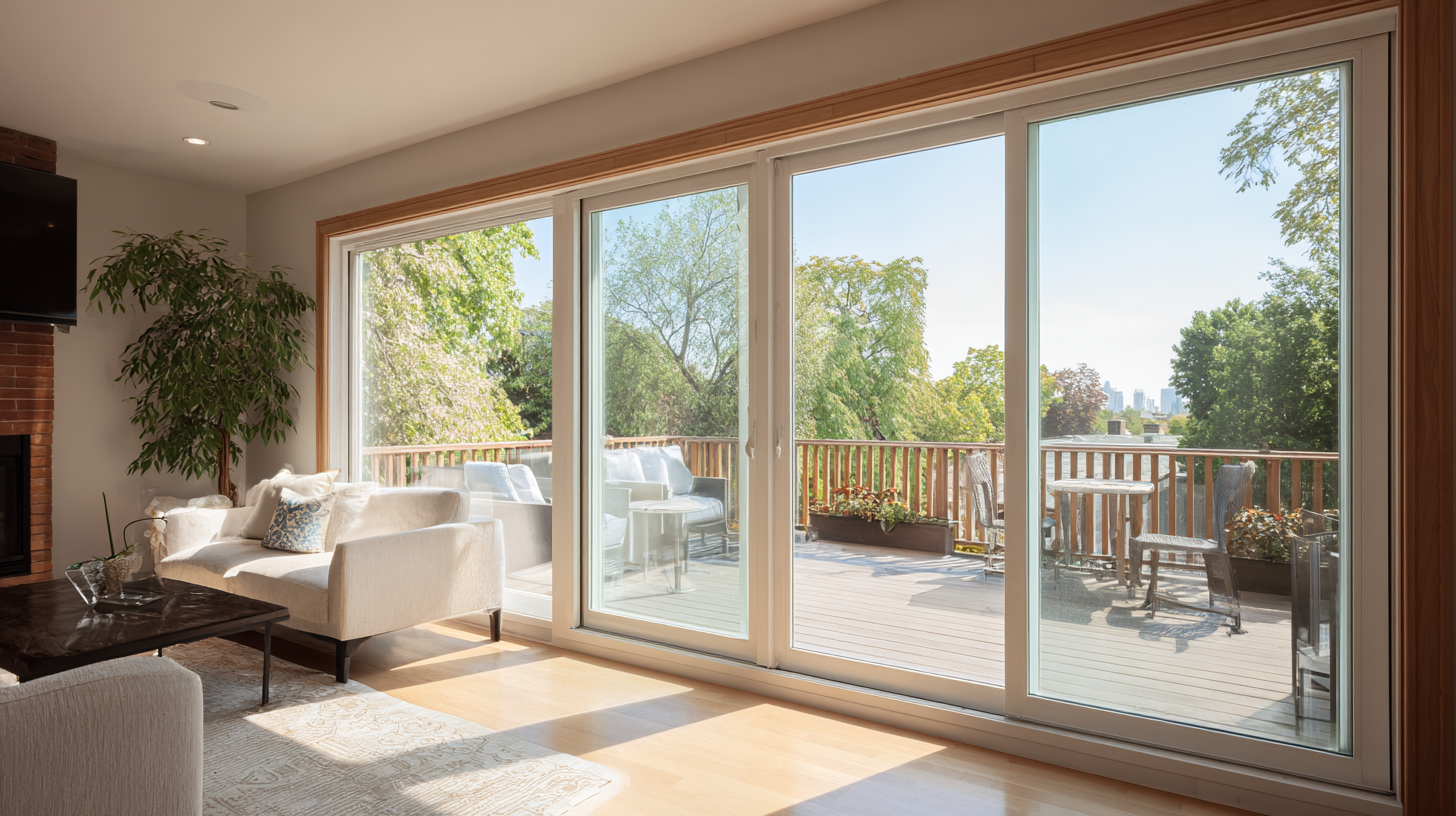Enhancing Your Living Space: The Benefits of Installing a Sliding Back Door
When it comes to enhancing the functionality and aesthetics of your home, the installation of a sliding back door can be a transformative decision. This modern architectural feature not only serves as a practical entry point to your outdoor space but also creates a seamless connection between your indoor and outdoor environments. A sliding back door allows for an abundance of natural light, making your living area feel more spacious and inviting. Beyond aesthetics, it offers numerous benefits such as improved ventilation and ease of access, making it perfect for gatherings and daily activities alike. In this guide, we will explore the advantages of incorporating a sliding back door into your living space and provide practical tips to help you select the perfect design that complements your home’s style and functional needs. Whether you aim to bring in more light, enhance your home's value, or create a smooth flow between your indoor and outdoor areas, the sliding back door can be an excellent addition to elevate your living experience.

Benefits of Increased Natural Light from Sliding Back Doors
Sliding back doors are an excellent choice for homeowners looking to enhance their living space by maximizing natural light and creating a seamless connection with the outdoors. With their expansive glass panels, these doors allow an abundance of sunlight to flood into your home, transforming any space into a brighter, more inviting environment. This increased natural light not only elevates the ambiance but also contributes positively to the mood and well-being of the inhabitants.
In addition to sliding doors, various alternatives exist that can similarly maximize light and provide stunning garden views, such as French doors or thoughtfully placed windows. Maintaining a light-filled home improves aesthetics and leads to a more pleasant atmosphere for gatherings and daily activities. Whether opting for sliding doors or other innovative solutions, enhancing your living space with natural light promises lasting benefits that resonate throughout your home.
Benefits of Increased Natural Light from Sliding Back Doors
Enhancing Indoor-Outdoor Flow with a Sliding Back Entrance
 Installing a sliding back door can significantly enhance the flow between your indoor and outdoor spaces. This type of entrance not only provides easy access to your patio or garden but also allows natural light to fill your interiors, creating a bright and inviting atmosphere. The seamless transition from inside to outside encourages a more engaging lifestyle, perfect for hosting gatherings or enjoying quiet moments in nature.
Installing a sliding back door can significantly enhance the flow between your indoor and outdoor spaces. This type of entrance not only provides easy access to your patio or garden but also allows natural light to fill your interiors, creating a bright and inviting atmosphere. The seamless transition from inside to outside encourages a more engaging lifestyle, perfect for hosting gatherings or enjoying quiet moments in nature.
Tips: When choosing a sliding door, consider the size of the opening to maximize the view and sunlight while ensuring it integrates well with your existing decor. Opt for energy-efficient glass to maintain a comfortable indoor temperature and reduce energy costs. Adding a sliding screen door can also enhance ventilation while keeping insects at bay.
Moreover, design your outdoor area to complement the sliding door. A well-placed patio set or flowering plants can create an appealing visual connection that draws the eye from the inside out. Consider adding outdoor lighting to enhance nighttime use of your back space, making it a cozy retreat ideal for evening relaxation or entertaining.
Improving Home Value Through Modern Sliding Door Installations
Installing a modern sliding back door can significantly enhance the value of your home. According to the National Association of Realtors, homeowners can expect to recoup approximately 76% of the cost of a sliding door installation upon resale. This figure reflects not just the functionality but also the aesthetic appeal that modern sliding doors bring to a property. The seamless transition between indoor and outdoor spaces is especially appealing in today's market, where buyers are increasingly looking for homes that facilitate a connection with their surroundings.
In addition to the return on investment, contemporary sliding doors offer energy efficiency benefits that can further entice potential buyers. The U.S. Department of Energy states that advanced glass technology used in sliding doors can reduce heating and cooling costs by up to 30%. Energy-efficient doors are seen as a hallmark of a well-maintained home, making it more attractive to environmentally-conscious buyers. As the demand for energy-saving features continues to rise, installing a sliding back door not only elevates your living space but also positions your home favorably in a competitive marketplace.
Maximizing Space Efficiency with Sliding Back Door Designs
Sliding back doors are an excellent choice for maximizing space efficiency in your home. Unlike traditional hinged doors that swing open, sliding doors utilize a horizontal track, allowing you to make the most of your available floor space. This feature is particularly beneficial for smaller homes or apartments, where every square foot counts. With a sliding back door, you can place furniture or other items near the entrance without worrying about obstructing the door's movement, leading to a more organized and functional living area.
 Additionally, sliding back doors often come with large glass panels, enhancing the natural light in your home while providing unobstructed views of your backyard or patio. This design not only makes your living space feel larger but also creates a seamless transition between indoor and outdoor areas. For homeowners looking to maximize both space and aesthetic appeal, sliding back doors present a stylish solution that can elevate the overall design of any room. By choosing the right sliding door design, you can effectively blend functionality with elegance, transforming your living space into a brighter and more open environment.
Additionally, sliding back doors often come with large glass panels, enhancing the natural light in your home while providing unobstructed views of your backyard or patio. This design not only makes your living space feel larger but also creates a seamless transition between indoor and outdoor areas. For homeowners looking to maximize both space and aesthetic appeal, sliding back doors present a stylish solution that can elevate the overall design of any room. By choosing the right sliding door design, you can effectively blend functionality with elegance, transforming your living space into a brighter and more open environment.
Choosing the Right Material for Your Sliding Back Door Installation
When considering the installation of a sliding back door, selecting the right material is crucial for both aesthetics and functionality. Common materials include wood, vinyl, and aluminum, each offering unique advantages. Wood provides a classic, warm look but requires regular maintenance to prevent rot. Vinyl is a low-maintenance option that resists fading, making it ideal for busy households. Aluminum is known for its durability and strength, perfect for those living in extreme weather conditions.
Tips for Choosing Sliding Door Materials:
1. **Climate Considerations**: If you live in an area with extreme weather, opt for materials like aluminum that can withstand harsh conditions without warping or cracking.
2. **Maintenance Needs**: Consider your lifestyle and how much time you’re willing to devote to upkeep. Vinyl is an excellent choice for those seeking a no-fuss solution, while wood offers beauty at the cost of additional maintenance.
3. **Energy Efficiency**: Look for materials with good insulation properties to enhance energy efficiency. Energy-efficient sliding doors can help reduce heating and cooling costs throughout the year.
By carefully weighing the pros and cons of each material, you can select a sliding back door that enhances your living space while meeting your specific needs.
Enhancing Your Living Space: The Benefits of Installing a Sliding Back Door
| Material Type | Durability | Energy Efficiency | Cost Estimate ($) | Maintenance Level |
|---|---|---|---|---|
| Vinyl | High | Good | 1000 - 2500 | Low |
| Wood | Moderate | Excellent | 1500 - 3000 | High |
| Aluminum | Very High | Moderate | 1200 - 2800 | Low |
| Fiberglass | High | Good | 1400 - 2900 | Moderate |



